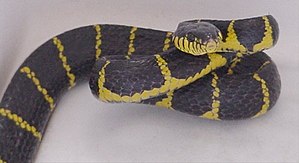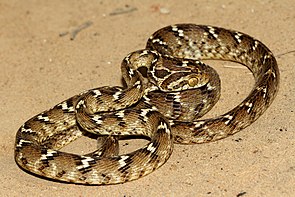Night tree snakes
| Night tree snakes | ||||||||||||
|---|---|---|---|---|---|---|---|---|---|---|---|---|

Mangrove night tree snake ( Boiga dendrophila ) |
||||||||||||
| Systematics | ||||||||||||
|
||||||||||||
| Scientific name | ||||||||||||
| Boiga | ||||||||||||
| Fitzinger , 1826 |
The night tree snakes ( Boiga ) are a genus of snakes from the subfamily of the real snakes (Colubrinae) within the family of the snakes (Colubridae), whose representatives are slightly poisonous.
features
Night tree snakes are a genus of medium-sized (maximum body length up to about 1.6 m) to large (maximum body length up to about 2.8 m) snakes.
The large eyes are often prominent and show vertically elliptical pupils. Because of the similarity with the eyes of cats, these snakes are also referred to as "cat snakes" in English.
The dentition is opistoglyphic ; in the back of the maxilla , 10–14 teeth of approximately the same size are followed by 2–3 elongated poisonous teeth with a deep groove along which the poison enters the bite wound.
They vary widely in their patterns and colors. Many have ribbons, others are spotted, and some are uniform in color. Mainly they are black, brown, or green with white and yellow accents.
distribution

The distribution area of the genus extends in southern Asia from Iran , Turkmenistan and Uzbekistan in the west via Tajikistan , Afghanistan , Pakistan and India to the east of the People's Republic of China and Taiwan . In the north they reach Nepal and Sri Lanka and the Andaman and Nicobar Islands in the south. They are widespread in the entire Southeast Asian area , including the Philippines , and at least one species ( Boiga irregularis ) reaches New Guinea , the north and east of Australia , the Solomon Islands and other islands in northwest Melanesia .
In some areas three to five species of the genus sympatric occur.
Way of life

As the German common name suggests, representatives of the genus Boiga are nocturnal tree dwellers. However, they stay on the ground more often than other typical tree-dwelling snakes and one species, the common night tree snake ( Boiga trigonata ), is predominantly found on the ground. They prefer forest areas as a habitat; Boiga trigonata is also native to the steppe areas of Central Asia.
The most common prey animals include lizards and small mammals as well as birds and their clutch of eggs . Diurnal lizards and birds are actively hunted during their resting phases. Nocturnal prey, such as bats, are probably also preyed on as ambulance hunters . Medium-sized Boiga species and juveniles of large species prefer lizards as prey. Adults of large species, on the other hand, are increasingly shifting their prey range to warm-blooded birds and small mammals.
All representatives of the genus are oviparous . Little is known about reproduction. Most of the information relates to observations on animals living in captivity and can only partially be applied to their behavior in the wild. Some species ( Boiga cynodon , Boiga cyanea , Boiga dendrophila , Boiga nigriceps and possibly Boiga guangxiensis ) can probably lay eggs several times a year. The mating time for most of the species for which the corresponding data are available is 2.5–4 hours, but for some species ( Boiga kraepelini , Boiga ceylonensis and Boiga multomaculata ) it can also last for 10–20 hours during the act Boiga guangxiensis has ended after just 10-20 minutes.
Toxinology
The venom of the night tree snake is produced by the Duvernoy's glands . The toxinology of the genus Boiga has so far only been researched to a limited extent. One of the reasons for this is that bites have clear but hardly threatening consequences in humans. The brown night tree snake ( Boiga irregularis ), which is an invasive species on Guam and adjacent islands, has fatal consequences, especially for the local bird fauna, gave rise to more detailed investigations .
As early as 2006, the monomeric three-finger toxin (3FTx) denmotoxin was detected in the glandular secretion of the mangrove night tree snake ( Boiga dendrophila ) . The polypeptide denmotoxin is a neurotoxin that blocks the nicotinic acetylcholine receptors on the neuromuscular endplate . This prevents the signal transmission from the nerve cells to the muscle fibers, which leads to symptoms of paralysis. The neurotoxic effect of denmotoxin is not universal, however, but about 100 times stronger in birds than in mammals.
Two years later, irditoxin was detected from the poison of the brown night tree snake ( Boiga irregularis ) . Irditoxin (according to " (Boiga) IRregularis DImeric TOXIN") is a heterodimer made of two different 3FTx units that are connected to one another via a disulfide bridge . The neurotoxic effect of irditoxin in reptiles and birds ( Diapsida ) is around 1000 times stronger than in mammals ( Synapsida ).
In 2018, the analyzes were expanded to include three additional species, the dog-toothed night tree snake ( Boiga cynodon ), the red night tree snake ( Boiga nigriceps ) and the common night tree snake ( Boiga trigonata ). The venom of all five species showed a preponderance of denmotoxin-like three-finger toxins. In three species ( Boiga dendrophila , Boiga irregularis and Boiga nigriceps ) the 3FTx also showed the necessary prerequisites for the formation of irditoxin-like dimers.
species


The Reptile Database currently lists (as of March 2020) 35 species. Two species from Africa ( Boiga blandingii and Boiga pulverulenta ) are now included in the closely related but independent genus Toxicodryas .
- Boiga andamanensis (Wall, 1909)
- Boiga angulata ( Peters , 1861)
- Boiga barnesii ( Günther , 1869)
- Boiga beddomei (Wall, 1909)
- Boiga bengkuluensis Orlov , Kudryavtzev , Ryabov & Shumakov , 2003
- Boiga bourreti Tillack, Ziegler & Le Khac Quyet, 2004
- Boiga ceylonensis ( Günther , 1858)
- Green night tree snake ( Boiga cyanea ( Duméril , Bibron & Duméril , 1854))
- Dog-toothed night tree snake ( Boiga cynodon ( Boie , 1827))
- Mangrove night tree snake ( Boiga dendrophila )
- Boiga dightoni ( Boulenger , 1894)
- White-spotted night tree snake ( Boiga drapiezii ( Boie 1827))
- Boiga flaviviridis Vogel & Ganesh, 2013
- Boiga forsteni ( Duméril , Bibron & Duméril , 1854)
- Boiga gocool ( Gray , 1835)
- Boiga guangxiensis Wen, 1998
- Boiga hoeseli Ramadhan, Iskandar & Subasri, 2010
- Brown night tree snake ( Boiga irregularis ( Merrem , 1802))
- Boiga jaspidea ( Duméril , Bibron & Duméril , 1854)
- Boiga Kraepelini Stejneger , 1902
- Boiga multifasciata ( Blyth , 1861)
- Spotted night tree snake ( Boiga multomaculata ( Boie , 1827))
- Red night tree snake ( Boiga nigriceps ( Günther , 1863))
- Boiga nuchalis (Günther, 1875)
- Boiga ochracea (Günther, 1868)
- Boiga philippina (Peters, 1867)
- Boiga quincunciata (Wall, 1908)
- Banded night tree snake ( Boiga saengsomi Nutaphand, 1985)
- Boiga schultzei Taylor, 1923
- Boiga siamensis Nutaphand, 1971
- Boiga tanahjampeana Orlov & Ryabov, 2002
- Boiga thackerayi Giri, Deepak, Captain, Pawar & Tillack, 2019
- Common night tree snake ( Boiga trigonata ( Schneider in Bechstein , 1802))
- Boiga wallachi Das, 1998
- Indian egg snake ( Boiga westermanni ( Reinhardt , 1863))
Individual evidence
- ^ M. Wrobel: Elsevier's Dictionary of Reptiles. 758 pp., Elsevier, 2004. ISBN 0-444-51499-6 (reading sample)
- ↑ a b c d H. W. Greene: Ecological, Evolutionary, and Conservation Implications of Feeding Biology in Old World Cat Snakes, Genus Boiga (Colubridae). In: Proceedings of the California Academy of Sciences , Vol. 46, No. 8, pp. 193-207, 1989. (digitized version )
- ↑ T. Ziegler, NL Orlov, TT Giang, NQ Truong, NT Tao, LK Quyet, NV Khoi & VN Thanh: New records of cat snakes, Boiga Fitzinger, 1826 (Squamata, Serpentes, Colubridae), from Vietnam, inclusive of an extended diagnosis of Boiga bourreti Tillack, Le & Ziegler, 2004. In: Zoosystematics and Evolution , Vol. 86, No. 2, pp. 263–274, 2010. (digitized version )
- ↑ NL Orlov & SA Ryabov: A new species of the genus Boiga (Serpentes, Colubridae, Colubrinae) from Tanahjampea Island and Description of "Black Form" of Boiga cynodon Complex from Sumatra (Indonesia). In: Russian Journal of Herpetology , Vol. 9, No. 1, pp. 33–56, 2002. (Abstract)
- ^ GH Rodda, Th. H. Fritts, MJ McCoid & EW Campbell III: An Overview of the Biology of the Brown Treesnake (Boiga irreguluris), a Costly Introduced Pest on Pacific Islands. In: GH Rodda, Y. Sawai, D. Chiszar & H. Tanaka (Eds.): Problem Snake Management: The Habu and the Brown Treesnake , pp. 44–80, Cornell University Press, 1999. (digitized)
- ↑ SA Ryabov & NL Orlov: Reproductive Biology of Boiga guangxiensis Wen, 1998 (Serpentes: Colubridae). In: Asian Herpetological Research , Vol. 1, No. 1, pp. 44–47, 2010. (Abstract)
- ^ SA Weinstein, DA Warrel, J. White & DE Keyler: "Venomous" Bites from Non-Venomous Snakes: A Critical Analysis of Risk and Management of "Colubrid" Snake Bites. 364 pp. Elsevier, 2011. ISBN 978-0-12-387732-1 (reading sample)
- ↑ a b D. Dashevsky, J. Debono, D. Rokyta, A. Nouwens, P. Josh & BG Fry: Three-finger toxin Diversification in the Venoms of cat-eye Snakes (Colubridae: Boiga). In: Journal of Molecular Evolution , 2018. doi: 10.1007 / s00239-018-9864-6 (digitized version )
- ↑ J. Pawlak, St. P. Mackessy, BG Fry, M. Bhatia, G. Mourier, C. Fruchart-Gaillard, D. Servent, R. Ménez, E. Stura, A. Ménez & RM Kini: Denmotoxin, a three-finger toxin from the colubrid snake Boiga dendrophila (Mangrove Catsnake) with bird-specific activity. In: Journal of Biological Chemistry , Vol 281, No. 39, pp. 29030–29041, 2006. (digitized version )
- ↑ J. Pawlak, St. P. Mackessy, NM Sixberry, EA Stura, MH Le Du, R. Ménez, Ch. Shin Foo, A. Ménez, S. Nirthanan & RM Kini: Irditoxin, a novel covalently linked heterodimeric three- finger toxin with high taxon-specific neurotoxicity. In: The FASEB Journal , Vol. 23, pp. 534-545, 2008. (digitized version )
- ↑ The Reptile Database: Boiga (accessed March 4, 2020)
- ↑ St. Spawls, K. Howell, H. Hinkel & M. Menegon: Field Guide to East African Reptiles. 2nd edition, 544 pp., Bloomsbury Publishing, 2018. ISBN 978-1-4729-3562-5 (reading sample)

